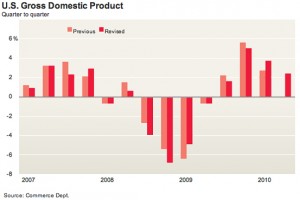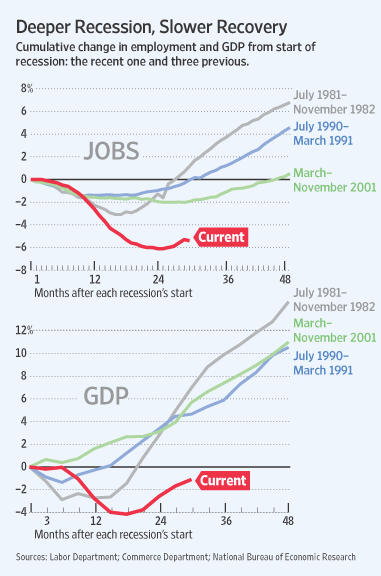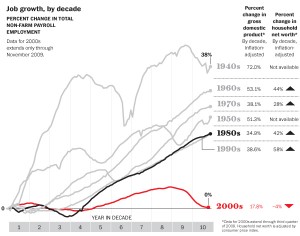Prevent the next deflation – What’s left for the Fed?
From Bernanke’s speech in 2003:
Should the funds rate approach zero, the question will arise again about so called nontraditional monetary policy measures. I first discussed some of these measures in a speech last November. Thanks in part to a great deal of fine work by the staff, my understanding of these measures and my confidence in their success have been greatly enhanced since I gave that speech.
Without going into great detail, I see the first stages of a “nontraditional” campaign as focused on lowering longer-term interest rates.
The two principal components of that campaign would be a commitment by the FOMC to keep short-term yields at a very low level for an extended period together with a set of concrete measures to give weight to that commitment.
Such measures might include, among others, increased purchases of longer-term government bonds by the Fed, an announced program of oversupplying bank reserves, term lending through the discount window at very low rates, and the issuance of options to borrow from the Fed at low rates. I am sure that the FOMC will release more specific information if and when the need for such approaches appears to be closer on the horizon.
Deflation Threat: Is America another Japan?
Does America face Japanese-style deflation?
America’s Lost Decade, part 4
This is a post following my previous posts on the same topic, see p1, p2, p3.
When discussing the issue, most people focus on GDP growth. Yes, in terms of GDP growth, in the past decade, the US still managed to grow 18%, cumulatively – that’s roughly 1.8 percent per year on average. However, in terms of employment growth, it has been a lost decade for the US (see the chart below).
(click to enlarge)
Given the economic dynamism in the US, and compare it to Japan, I have long thought the Lost Decade would never happen in America, a land full of opportunities.
I guess I need to re-visit my presumptions — Whether a big housing bubble (in the US’ case, two big bubbles in one decade) always foretells anemic economic growth afterward, as opposed to the common belief that Japan’s lost decade was largely due to policy mistakes. Maybe, in the aftermath of a big bubble, America and Japan are really not that much different – an open question.
Four generations of iPhone compared
Compare speed of the four generations of Apple iPhones.
Time to upgrade my iPhone from 1G to 3G 🙂 (no 4G yet, due to its reception flaw and slow start-up).
Household debt in foreign currency drags Europe’s growth engine
Eastern Europe, like other emerging markets, had been investor's darling before the crisis hit in 2008. People bet money on its faster economic growth due to better demographics and cheap labor and resources compared to the more developed Western Europe.
Eastern European countries also liberalized their financial sector and allowed entry of mega European banks from France, Swiss, and Germany. Since most of these countries are still not part of the Euro-zone, foreign banks only provided credit in foreign currencies, such to Euro and Swiss Francs. Domestic households underestimated the currency risk – who would have anticipated a big unprecedented financial crisis is coming.
With currencies in these countries plunging, household debt sometimes doubled to the pre-crisis level. What choices left? Default and government bailout. No matter what measures taken, the once growth engine of Europe now became the heavy drag.
Eastern Europe's problem is not unusual. It drew parallels to the Club-Med (southern European) countries that joined European Union earlier. Both were huge credit bubbles fueled by optimistic view that the ever integrated European continent will bring tremendous growth opportunities. The difference in the case of Greece was that joining Euro-zone reduced their borrowing costs significantly for both government and households (compare the credit spreads before and after joining the Euro, you will see). The much cheaper credit not available before made both people (and governments) think they are now artificially richer. And boom, they went on spending (and speculation) spree. A big cause for European housing bubble.
So don't blame Greek or Eastern Europeans, blame the fatally flawed idea of "Europe as ONE".
Now read this fascinating story from WSJ:
BUDAPEST—Dezso Kocs's family restaurant was booming in 2007. To build a bigger kitchen and renovate the dining room, he and his wife borrowed the equivalent of $150,000.
It's a decision they now regret. Like many Hungarians then, they took the loan in Swiss francs, since the interest rate was far lower than if they had borrowed in their local currency, the forint. But after the global financial crisis hit in 2008 and the forint plummeted, the Kocs's monthly payments nearly doubled.
…
Households and small businesses across Central and Eastern Europe are sinking under the weight of foreign-currency debts.
It's a sign of how the problems facing the region's financial system go beyond the borrowing by spendthrift governments that has been the main focus of investors.
The rising number of borrowers' defaults already has hit bank profits. Ratings agencies warn that the exposure to foreign-currency lending could hurt the creditworthiness of financial institutions in the region.
Hungarian households collectively have about $32 billion in outstanding foreign-currency debt, mostly in Swiss francs and euros, according to the Hungarian central bank. Aside from local players, about a half-dozen foreign banks—from Austria and elsewhere in Europe—have a significant presence in Hungary.
The larger international lenders generally are viewed as diversified enough that troubles in Hungary aren't likely to pose a serious threat. Regulators say banks operating in Hungary have shored up their finances and are in better shape to withstand further shocks than at the start of the financial crisis.
But consumers' debt woes are acting as a brake on the region's economic recovery as households use income to pay off loans instead of spending, damping domestic demand. The foreign-currency borrowings also constrain economic policy makers since swings in interest rates and currency values can drastically change the fortunes of indebted households and companies.
In Romania, one of the European Union's poorest members, more than 60% of household borrowing is in foreign currency. In Poland, the figure is 36%. In the Baltic states, the proportion ranges from 70% to more than 90%.
In Hungary, nearly 70% of the country's total household debt was borrowed in foreign currency. The sharp slide in the Hungarian forint, which since the summer of 2008 has fallen about 20% against the euro and some 30% against the Swiss franc, has meant large increases in the local-currency cost of repaying these loans.
…
China’s healthcare boom
China is in economic restructuring. Building affordable healthcare and social security system are on the top of the reform agenda (this helps drive down China's savings rate so to avoid crisis in the future fueled by global imbalance). Foreign companies will have tremendous business opportunities in China.
That nation plans to spend $125 billion to build tens of thousands of hospitals and clinics, extending health care to nearly all of its citizens. Its ambitious three-year plan, announced last year, has created a rare feeding frenzy in the lucrative field of diagnostic-imaging machines, an area in which Western manufacturers still face little Chinese competition.
…
Indeed, China's total medical device and equipment market is expected to roughly double between now and 2015 to $53.7 billion, according to market-research firm Frost & Sullivan. That figure includes products ranging from patient-monitoring devices to stents, but much of the growth will likely come from MRI and CT scanners, which are highly profitable and can cost up to $2 million apiece. And the likely sales come amid a protracted slump in the U.S. market for medical equipment and devices triggered by the economic slump.
"The efforts made by the Chinese government are unprecedented" in terms of investing in health-care infrastructure and spending on higher-tech equipment, says Ronald de Jong, chief executive of Philips Healthcare's emerging markets business.
GE and Philips project double-digit increases in their health-care operations in China over the next few years, while Siemens says it aims to increase medical-imaging sales there at a faster pace than the market's projected 10% annual growth. Last year, GE says, it generated $1 billion in Chinese health-care revenue, including equipment sales, parts sales and maintenance fees. It declined to disclose its U.S. sales figures, but the overall U.S. market for medical-imaging equipment and services fell by one third last year to $9.7 billion from $14.4 billion, according to market research firm Frost & Sullivan.
GE remains the top seller of medical-imaging devices globally and in China, but both Siemens and Philips are gunning to expand their Chinese market shares. To cater to smaller and more rural hospitals, all three companies have opened more sales and service offices across China's interior. They are also expanding less costly, lower-end lines of imaging gear.
GE, which plans to increase its 4,000-employee health-care work force in China by as much as 15% this year, has expanded its line of lower-priced Brivo imaging equipment beyond X-ray machines and into CT scanners that are roughly 30% less expensive than the company's costlier models. GE says it has sold 70 Brivo scanners in China since they were introduced in March.






![[HULOANS]](https://sg.wsj.net/public/resources/images/P1-AW443_HULOAN_NS_20100727175629.gif)
![[MEDCHINA]](https://sg.wsj.net/public/resources/images/MK-BE828_MEDCHI_NS_20100726183232.gif)